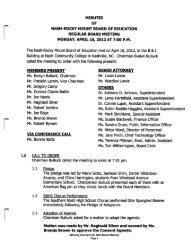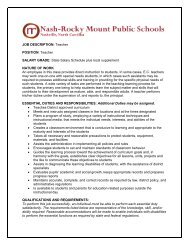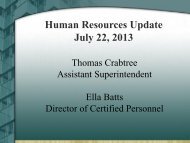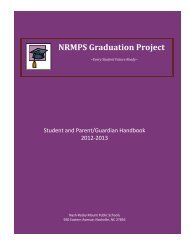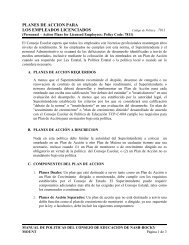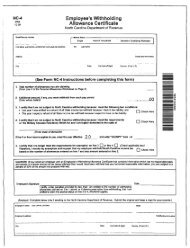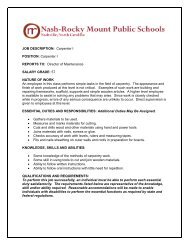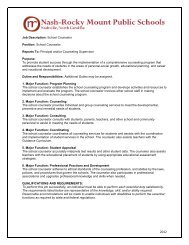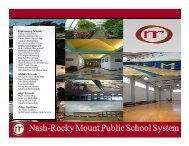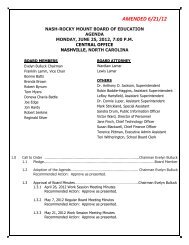2013-14 Student/Parent Handbook - Nash-Rocky Mount Schools
2013-14 Student/Parent Handbook - Nash-Rocky Mount Schools
2013-14 Student/Parent Handbook - Nash-Rocky Mount Schools
Create successful ePaper yourself
Turn your PDF publications into a flip-book with our unique Google optimized e-Paper software.
School records are maintained and kept by the school office in a secure location. They contain a list of credits,<br />
standardized test results, academic portfolios, grade-point averages, behavioral and psychological evaluations,<br />
screening and health records, attendance and disciplinary records, directory information, and a list of activities.<br />
In order to inspect, review, or transfer educational records, the eligible student and/or the parent/guardian must<br />
complete a request form. Other than school staff, no additional person may inspect, review, or transfer student<br />
educational records without:<br />
• the written consent of the eligible student<br />
• the written consent of the parent/guardian if the student is under 18 years of age, or<br />
• a properly issued court order, except under the conditions specified in FERPA.<br />
Under the provisions of FERPA, the district may release educational records to other school systems, colleges, and<br />
universities to which the student intends to enroll or transfer without written consent. The district may also release<br />
directory information, including name, date of birth, dates of attendance, current school, participation in school<br />
activities and sports, degrees and awards received without consent unless the eligible student and/or parent/ guardian<br />
notify the student's principal in writing not to release the information included as directory information in the<br />
student record. Policy Code: 4700<br />
STUDENT ATTIRE<br />
The board believes that the dress and personal appearance of students greatly affect their academic performance and<br />
their interaction with other students. The board requests that parents outfit their children in clothing that is<br />
conducive to learning. The board prohibits any appearance or clothing that does the following:<br />
1. violates a reasonable dress code adopted and publicized by the school;<br />
2. is substantially disruptive;<br />
3. is provocative or obscene; or<br />
4. endangers the health or safety of the student or others.<br />
Examples of prohibited dress or appearance include, but are not limited to, exposed undergarments; sagging pants;<br />
excessively short or tight garments; bare midriff shirts; strapless or spaghetti strap shirts; attire with messages or<br />
illustrations that are lewd, indecent or vulgar or that advertise products or services that are not permitted by law to<br />
minors; head coverings of any kind; see-through clothing; attire that exposes cleavage; any adornment, such as<br />
chains or spikes, that reasonably could be perceived as or used as a weapon; and any symbols, styles or attire<br />
frequently associated with intimidation, violence, or violent groups. Policy Code: 4316<br />
TECHNOLOGY RESPONSIBLE USE Policy Code: 3225/4312/7320<br />
Technological resources, including computers, other electronic devices, programs, networks and the Internet,<br />
provide opportunities to enhance instruction, appeal to different learning styles and meet the educational goals of the<br />
board. Through the school system’s technological resources, users can observe events as they occur around the<br />
world, interact with others on a variety of subjects, and acquire access to current and in-depth information.<br />
Use of technological resources should be integrated into the educational program. Technological resources should be<br />
used in teaching the Common Core State Standards and in meeting the educational goals of the school board. The<br />
curriculum committee should provide suggestions for using technological resources in the curriculum guides in<br />
accordance with any administrative regulations developed by the superintendent. Teachers are encouraged to further<br />
incorporate the use of technological resources into their lesson plans.<br />
The superintendent shall ensure that school system computers with Internet access comply with federal requirements<br />
regarding filtering software, Internet monitoring and Internet safety policies. The superintendent shall develop any<br />
regulations and submit any certifications necessary to meet such requirements.<br />
A. REQUIREMENTS FOR USE OF TECHNOLOGICAL RESOURCES<br />
The use of school system technological resources, such as computers and other electronic devices, networks,<br />
and the Internet, is a privilege, not a right. Before using the Internet, all students must be trained about<br />
appropriate on-line behavior. Such training must cover topics such as cyber bullying and interacting with others<br />
11



